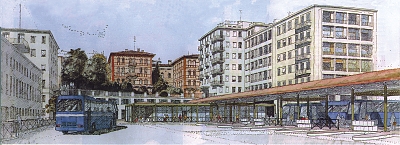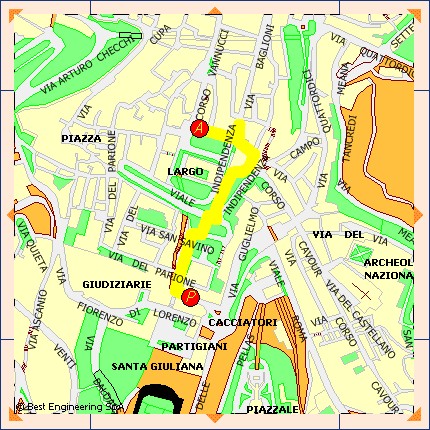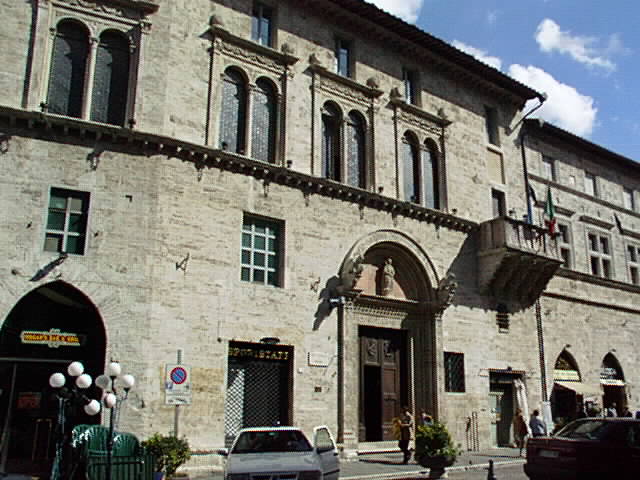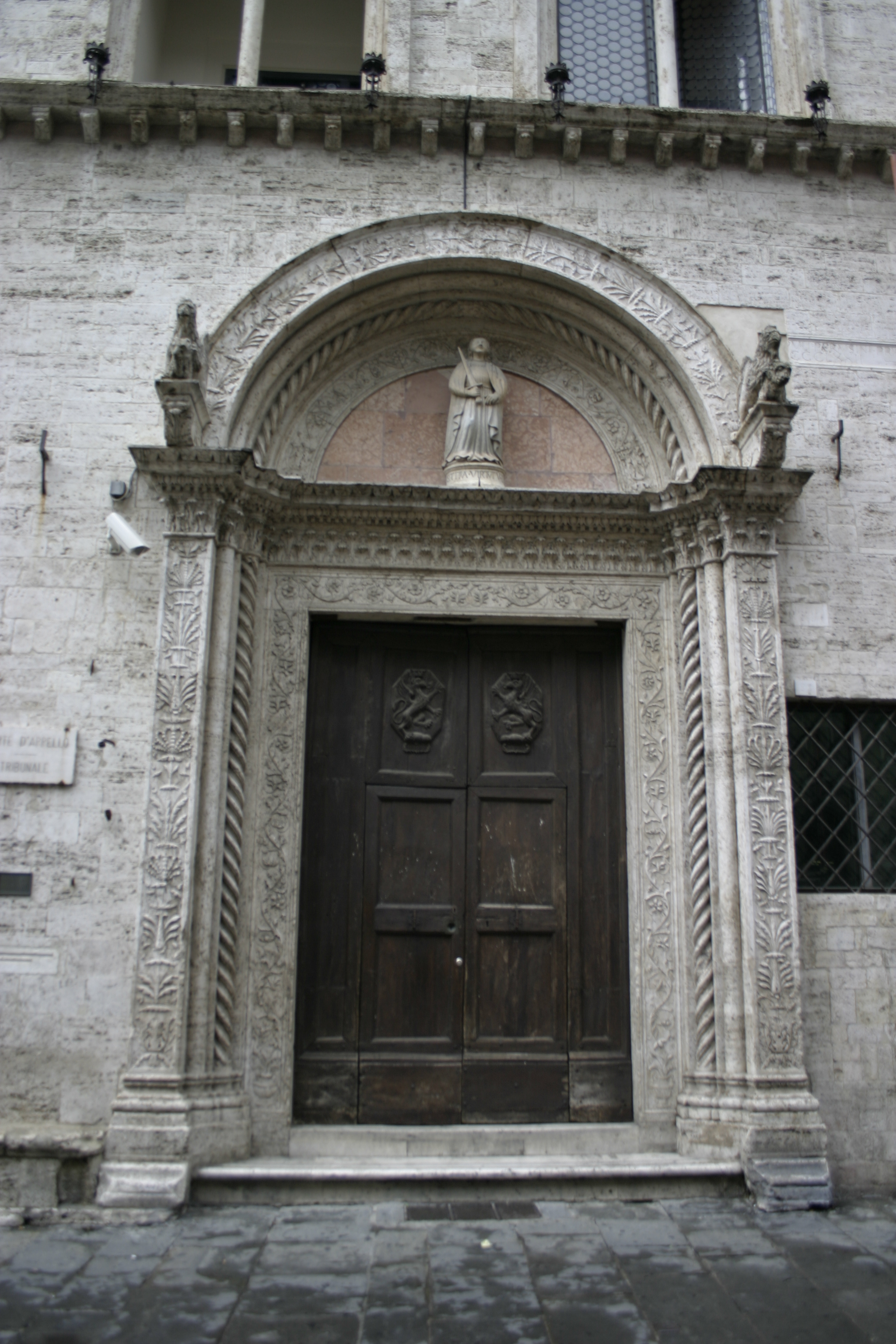We began the day with a lecture on Contemporary Italian Society by Antonella Bazzoli, who is a free lance journalist with a particular interest in Umbrian history, art and culture. She took her university degree in Political Science, and she resides in Perugia.
Waited out a rain shower after the class, then gathered our courage and took a bus up to the city center. We could have simply used the escalators, but we wanted to ride a bus. We tried to buy tickets at the main station (just across the street from our hotel, pictured just behind the bus depot ... it appeared to be just in front of our hotel), but the driver told us (we figured this out with the help of another passenger) to buy them at the next stop. So we did that, but the bus took off before we could validate the tickets. In essence, we ended up having a free ride. You can trace the route by going to the bus website and then click PLEASE CLICK HERE and then Calcola Percorso e Mappe and then clicking the first map and then click the Calcola Percorso button tell it to calculate a route going from street "Via L. Masi" number "9" (from the hotel's webpage) to "Piazza Italia". You get the map shown, with "P" (partenza, departure) to "A" (arrivo, arrival). As you can see, the bus parallels the walk to the tunnel at first (the brown line), then takes a winding route up the hill, around the Rocca Paolina (under the word "Largo" in the center of the map).
We did a little looking around along the Corso Vannucci, walked down the Via Mazzini to the Piazza Matteotti where that building pictured to the left (Palazzo del Capitano del Popolo aka P. del Bargello, erected between 1472 and 1481) is located. The statue over the door is Justice. This is where the police and courts operated. The Piazza is where they used to burn witches (eerie feeling knowing that).
We next took the Via dei Priori to find the Chiesa di Santi Stefano é Valentino. We succeeded, though most of the church is wrapped in scaffolding for restoration. We photographed the bell tower and door. Just after I shot the picture of the door the man standing in front of it moved so I could take the pic without him in it. I like it better with him in since it gives a much better sense of just how tiny the building is.
We continued past the Torre degli Sciri, a surviving family tower fortress from the 12th century (the others were demolished when their families were exiled), on down to the Oratorio of San Bernardino in the Piazza San Francesco, a large grassy area by the oratory and Perugia's Church of San Francesco. The oratory dates from the 15th century and its beautiful facade is made of pink, white, and black marble. Inside is an altar made from a 4th century paleochristian sarcophagus. Unfortunately, Chiesa San Francesco had fences all around it. Apparently earth shifts have left its future in doubt.
We returned UP (a seemingly very long way up) the via dei Priori, stopping at the Church of Sant'Agata -- simple, clean, serene. Unfortunately it was far too dark inside to get many good pictures (there was a very nice baptismal font and some nice, if faded, frescoes). The outside couldn't be pictured either; just too small and scrunched up between other buildings. Finally, again passing those three Gypsy musicians and a so-so dancing girl, we returned to the Corso. All in all, a very charming street and well worth the time.
Museo Archeologico Nazionale dell'Umbria
At three o'clock the group went to the Archaeological Museum for a tour with Claudia. The museum is surprisingly close to the hotel ... surprizing, because it didn't seem that way from the maps in our guidebooks. Our hotel is at the center-bottom of the accompanying map, just under "Via M". Go from there through the "Tre Archi" to the "Museo Archeologico". It is located on two floors in what had been the loggia and dining rooms of the convent of San Domenico, built between 1455 and 1579. It surrounds a simple large garden. It's a fascinating collection of Etruscan artifacts, including the recreation of an intact Etruscan tomb which was discovered in Perugia in the 1980's through a hole under a farmer's feet. Shown here are dozens of funerary ashes boxes, including several of couples. We also visited San Domenico, just next door, a big out-of-scale barn so far as we could tell, but maybe we were church-sated (or simply tired) at this point. We were too tired to stay for an organ recital by Helen Kingsley; everyone said it was delightful.






At 5:30 we had a session on Umbrian cuisine with an energetic lady named Agnese Battaglia, whose honors thesis at Arizona State was a socio-cultural analysis of traditional Umbrian festivals and who is currently pursuing a theology degree at the Istituto Teologico of Assisi.
Dinner out When the lecture was over we discovered that it was pouring rain, and it hadn't let up much when we met Babette, Gianina and Frank at 7:15 to go out for dinner. But we had our umbrellas and coats, so we "braved the elements" (not much bravery required from constantly rain-soaked viaggiatori from the Great Pacific Northwest). Fortunately, most of the way was on the escalators, in the Rocca Paolina and well out of the weather.
The weather may have played a role in our making a quick decision about where to go for dinner, choosing La Rosetta, just off the Piazza Italia. It had been recommended by both our Umbrian guidebooks, and we had a very good dinner, with bottles of Rubesco (the official drink of this trip, apparently). When we left Rosetta, fully sated, the rain had stopped and everything was clear and crisp for our return to Sangallo.
INDEX - PREV - NEXT
|
|



























